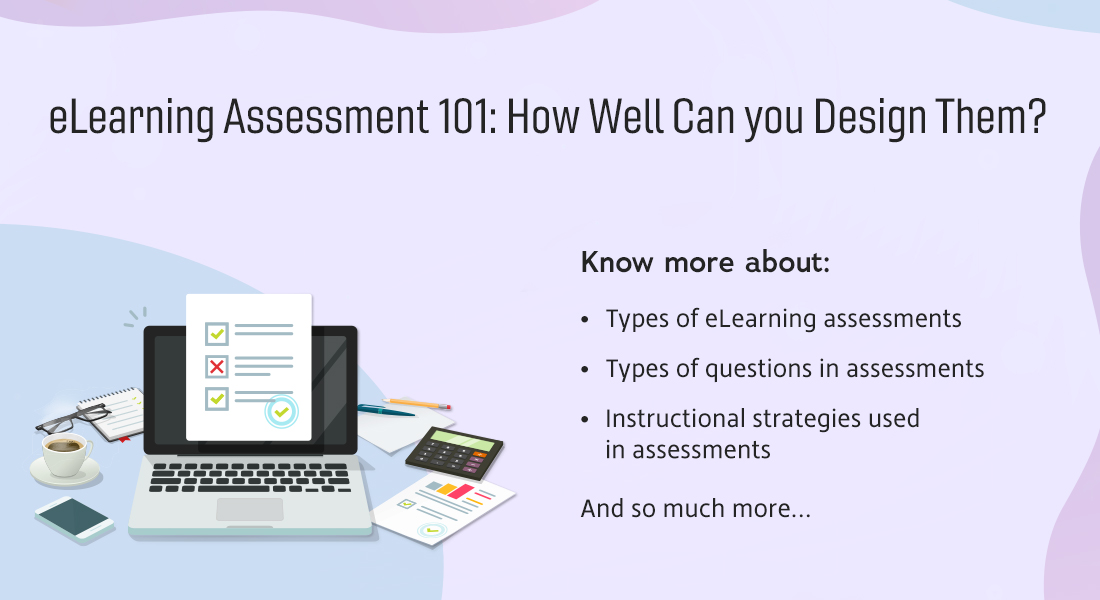Six Steps for Writing Perfect eLearning Assessments

We all know that eLearning assessments are one of the key components of any online course or training program as they determine the quality and effectiveness the course. In fact, assessments are as important as the quality of the training you impart to your employees. If the assessments in a course are below par, it is more than likely your course will not get the desired outcome, and you cannot assess if learners have achieved the set learning objectives.
Find out how to become an eLearning champion.
Good eLearning assessments determine:
- The effectiveness of the training program
- The amount of knowledge transfer that has taken place
- Whether the training program has met the learning objectives
Six Steps to Write eLearning Assessments
- Align assessments with learning objectives and content
- Review assessment items for content validity
- Write clear instructions
- Create an answer sheet that includes content screen references
- Pilot the assessment
- Implement the assessment
In the previous blog, we spoke about how to plan eLearning assessments. In this blog, let’s discuss how to write effective assessments.
Six Steps for Writing E-learning Assessments
1. Align your assessments with the learning objectives and content
The three components of any training program – learning objectives, training content, and assessments – work in tandem with each other. First, you need to have clearly defined learning objectives, then include training content that is aligned with the learning objectives, and lastly, design assessments to ensure learners are tested on what they are expected to learn and not something else.
- Learning objectives should clearly define the knowledge and skills learners would acquire at the end of the course.
- Training content should be chosen to help the learner meet the learning objectives.
- Assessments should measure the extent to which learning objectives are met.
An important thing to remember is to include detailed feedback (by response) in formative assessments to reinforce learning and enable the learner to learn from their mistakes.
2. Review eLearning assessment items for content validity
Reviewing content validity essentially is evaluating if the assessment actually measures what it is intended to measure.
All e-learning assessment items must match the:
- Performance, conditions, and criteria specified in the objectives
- Level of performance specified in the objectives
- SME approved content and focus on relevant content related to job performance, not anything else
Read how you can help your busy internal SME contribute to eLearning!
3. Write clear instructions
Instructions for your eLearning assessments must clearly state:
- What learners are supposed to do
- How they are to respond to the questions
- Where they are to provide their responses (paper, form, online)
- How much time they have to complete the assessment
4. Create an answer sheet that includes content screen references
The answer key should:
- Highlight the correct responses by bolding the answers
- Be formatted to match the type of eLearning
- Include a reference to the screen number where that content is covered
- Be provided to the LMS administrators for testing and integration.
5. Pilot the assessment
Along with the eLearning content, it’s critical to pilot-test your assessments. Pilot-testing the eLearning assessment will help find errors or problems as well as opportunities for improvement. Include scoring and tracking where appropriate, and make revisions as needed.
Your pilot test should identify whether:
- The instructions are clear
- There are any questions with no clearly correct response
- There are any questions with more than one correct response
- There are sections of the course not covered by any of the questions
- The information in the items is accurate
- There is any ambiguous or confusing wording
6. Implement the assessment
Once you’ve designed the eLearning assessment, ran the pilot assessment, and made suitable revisions, it’s time to implement the assessment in four simple steps:
- Integrate the assessment within the eLearning program
- Test the final assessment with an LMS for administration and tracking
- Include the assessment in the instructor and participant material as designed
- PROVIDE AN ANSWER KEY!
To Sum Up
E-learning assessments are an important part of eLearning and should be designed with the same amount of care and effort you put into designing the course. eLearning assessments are much more than posing random questions at the end of a course. And that’s what this blog wanted to emphasize. Want to know more about designing perfect eLearning assessments? Register for this mini masterclass on mastering eLearning assessments!


![Why Use Confidence-based Assessments in eLearning [Infographic] Why Use Confidence-based Assessments in eLearning [Infographic]](https://blog.commlabindia.com/hs-fs/hubfs/Imported_Blog_Media/confidence-based-assessments-elearning-infographic.png?width=901&height=2234&name=confidence-based-assessments-elearning-infographic.png)



